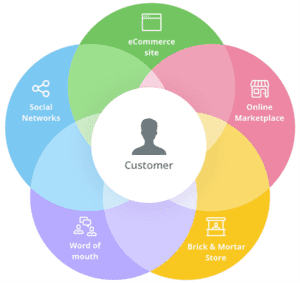26.08.20
Omni-channel marketing is a sales approach that integrates all market touchpoints and channels. This creates a synergized and consistent brand experience for your prospective buyers both in the real world and online.
This article outlines the role of signage in an omni-channel marketing strategy, and includes insights on how it is driving change in the retail industry.
How Does Omni-Channel Marketing Work?
The goal of Omni-channel marketing is to tell a seamless story through each of your touchpoints so that customers can build a relationship with your brand and products.
If a buyer wants to engage with you, an omni-channel strategy will provide multiple touch points to do so. This could be online, on a phone or computer, or over the phone or in your brick and mortar store. According to Emarsys*, this type of marketing is best achieved when the customer experience is seamlessly integrated. An example of this is when a potential client sees your signage and it reflects the same brand messaging as your other channels, website, Facebook etc.
Omni-channel customer experience strategies look at the process to align marketing efforts, so each effort reinforces the next and works collectively. Hence the prefix, “Omni” is Latin and defined by the English dictionary as “combining form meaning”.


What Role Does Signage Have to Play in Omni-Channel Marketing?
Brand signage and store fit-outs are interconnected touchpoints with your customer. Signage must fit a detailed set of specifications to remain consistent with the various other touchpoints. If one link in the “omnichannel” is broken, then the return on marketing investment may be affected.
Signwriters need to achieve a unique brand fit-out to make sure that the signage “link” of the omni-channel marketing efforts is strong. This requires project management experience with architects and fit-out specialists who have the ability to deliver fully customised signage to the unique requirements and specifications outlined by the omni-channel marketing and branding strategy. The signage specialist should understand the importance of this and respect the work that went into developing the strategy by following the specifications with precision and without taking shortcuts.


Tips on How to Start Implementing Omni-Channel Marketing.
There are a multitude of integrated omni-channel marketing strategies and tactics. From a signage perspective, one of the strategies used is changing the format of the retail store. These days customers and potential buyers expect retail spaces to be a real-world extensions of what they have experienced through your online marketing efforts.
This can be done using large touch screens that assist the customer with viewing various products without having to browse the store. Another strategy may include QR codes around the store using promotional signage that encourages shoppers to interact with the store online and in real life at the same time using their smartphones.
You need to design your signage with all the touchpoints in mind, and we can help. If your logo is displayed in a certain way on the website and social media then it needs to be replicated on the side of your building using bespoke high-quality signage fabrication. We specialise in the use of the latest illuminated lightbox display technology that can be easily and cost-effectively changed out to display the latest promotions or whatever is currently being marketing online. This ensures that the customer sees the same promotions displayed in the store window as they saw on their phone before deciding to visit the brick and mortar store.
References:
- Emarsys – The Differences Between Multichannel & Omnichannel Marketing
https://signwiseauckland.co.nz/?p=477&preview=true



